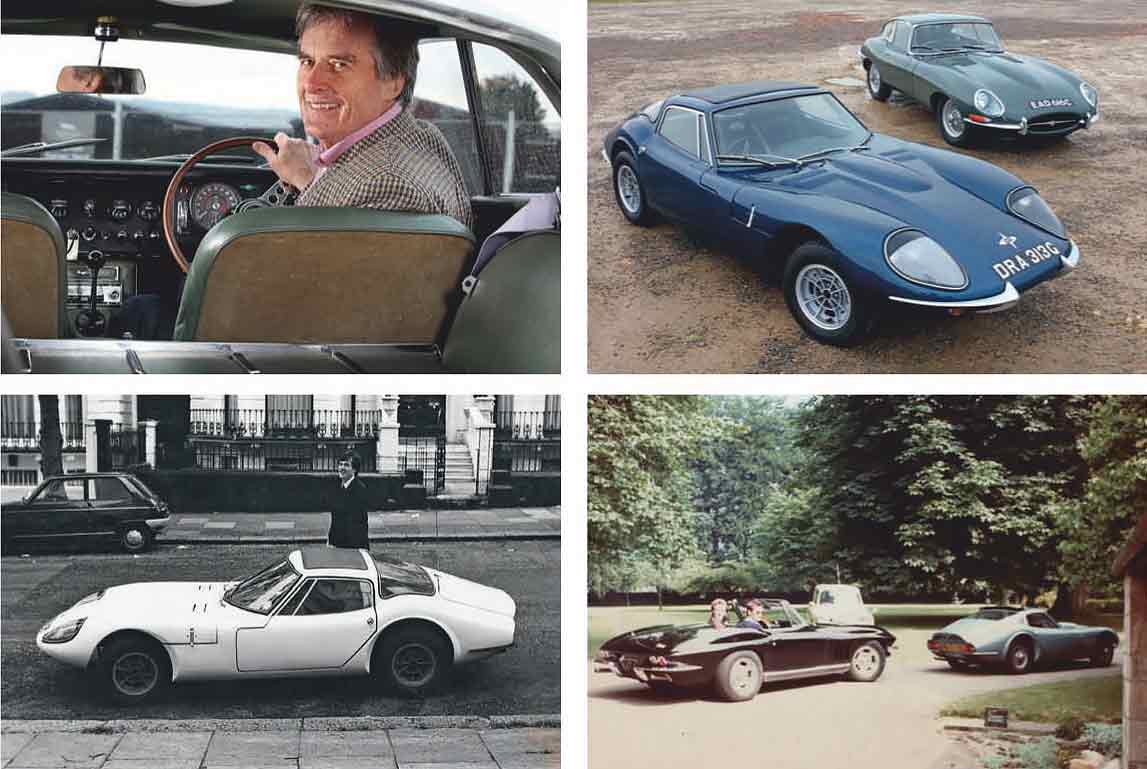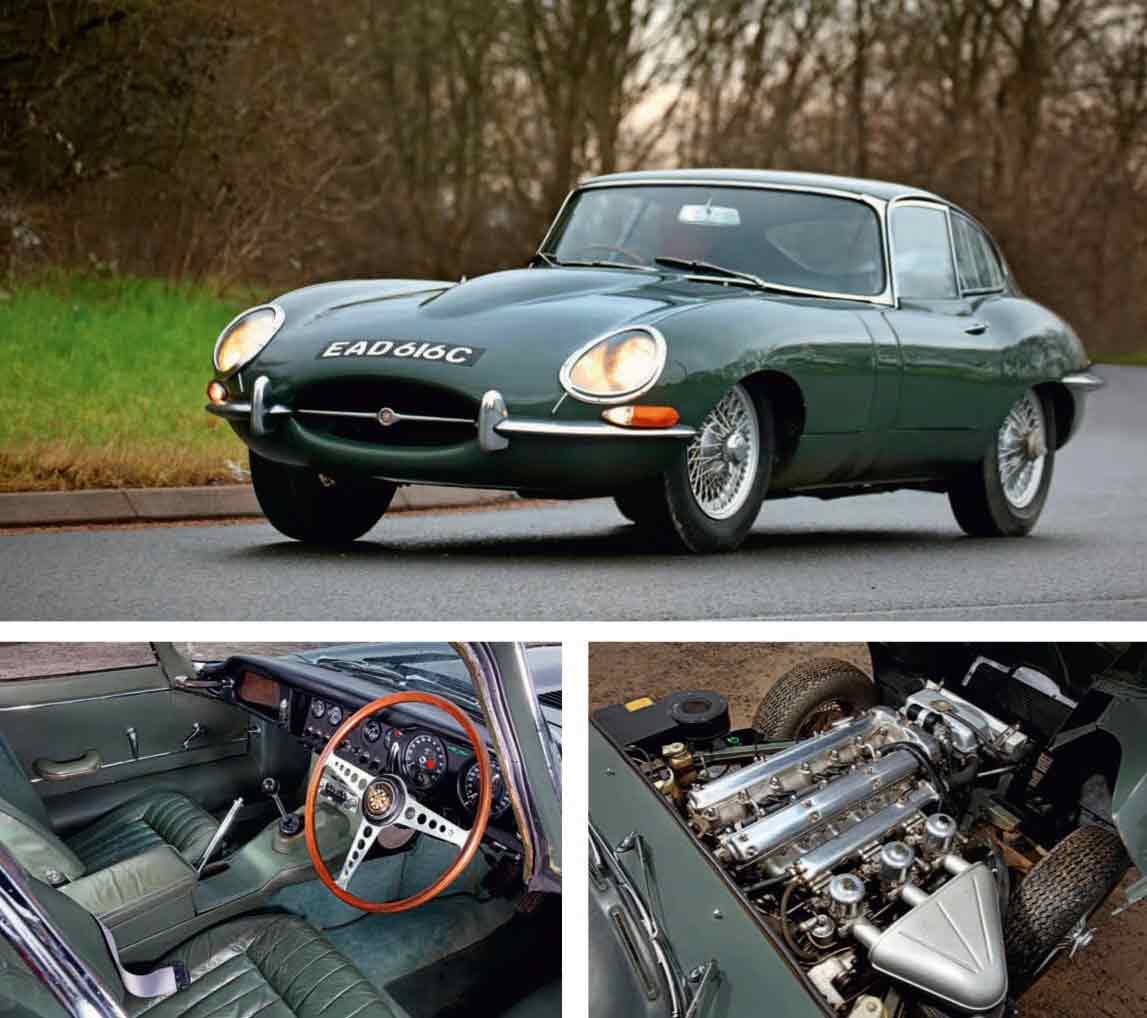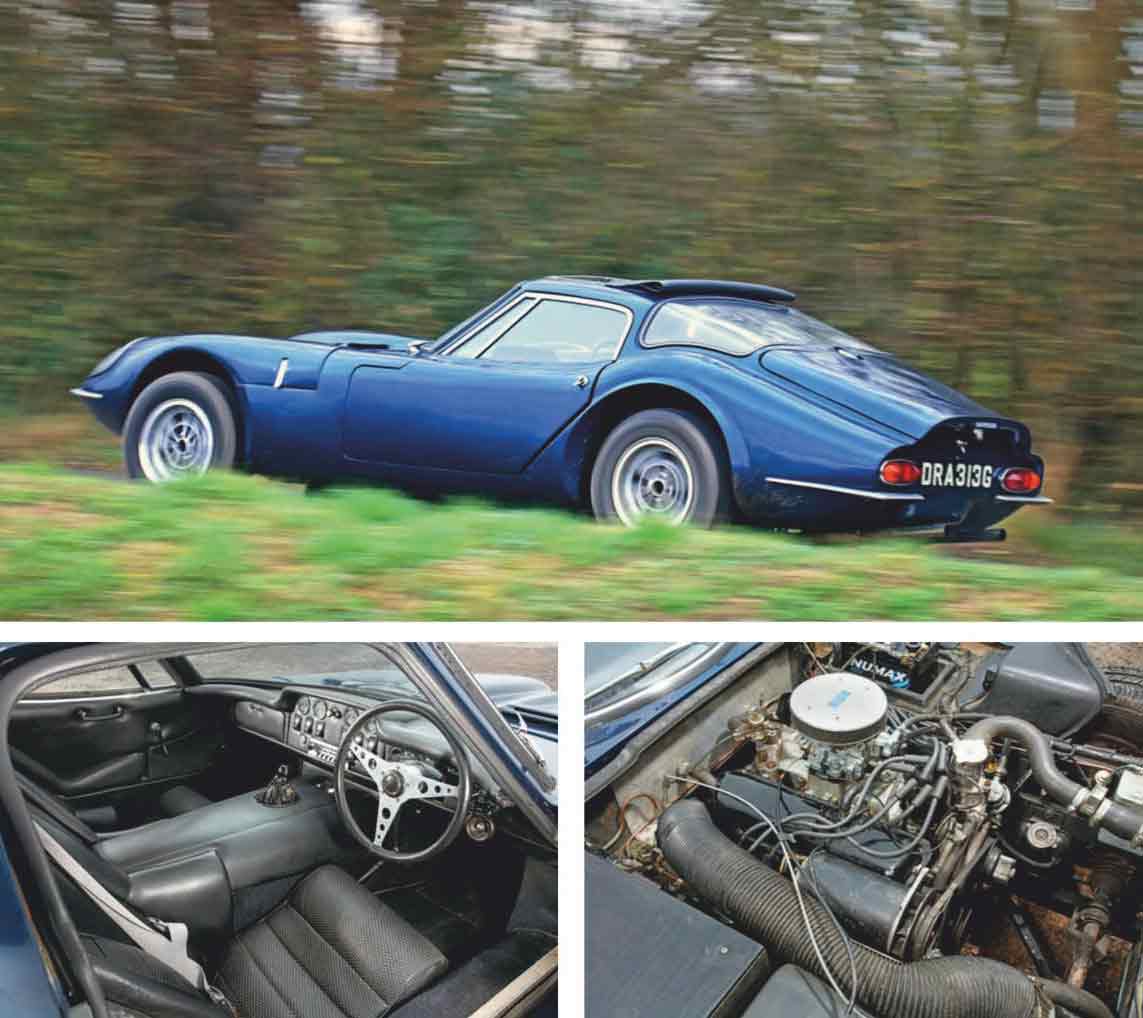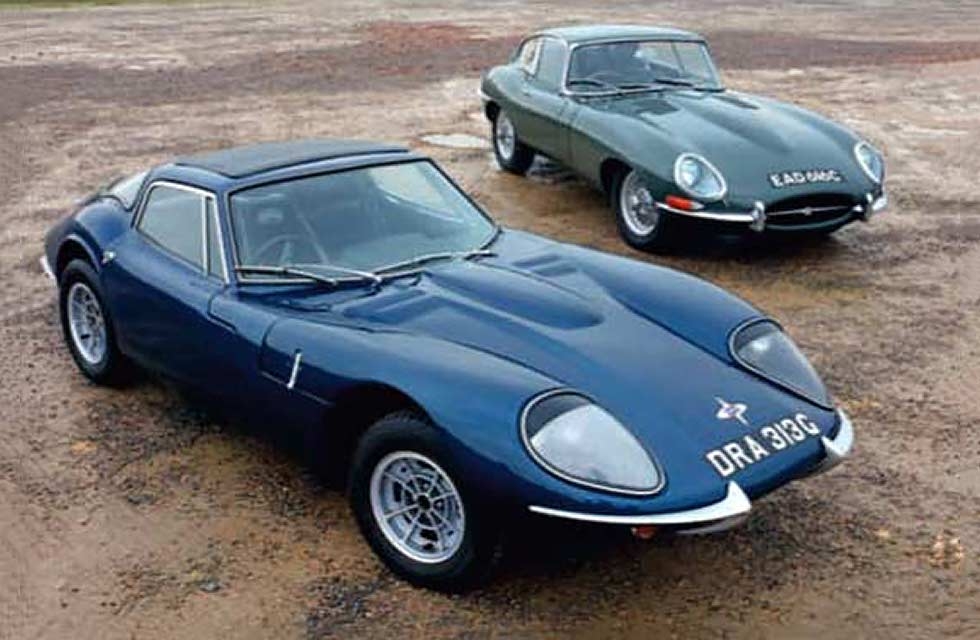
E’s company for Marcos. These two British GTs make unlikely bedfellows… unless you own one of each. Words Martin Buckley. Photography James Mann.
THE ODD COUPLE
Martin Buckley meets a man who rates his E-type second best… to a Marcos!
At first glance, a Jaguar E-type and Marcos GT 3-Litre don’t seem to offer many obvious points of comparison. Arguably at its best with the Ford V6, the West Country-bred Marcos emerged from a very different place – technically, intellectually and geographically – to the Coventry-born E-type. When the first of these Adams brothers-styled Marcos GTs appeared at the 1964 Racing Car Show, the fabulously fast and ravishingly beautiful Jaguar was already a ’60s legend, a social and cultural phenomenon.
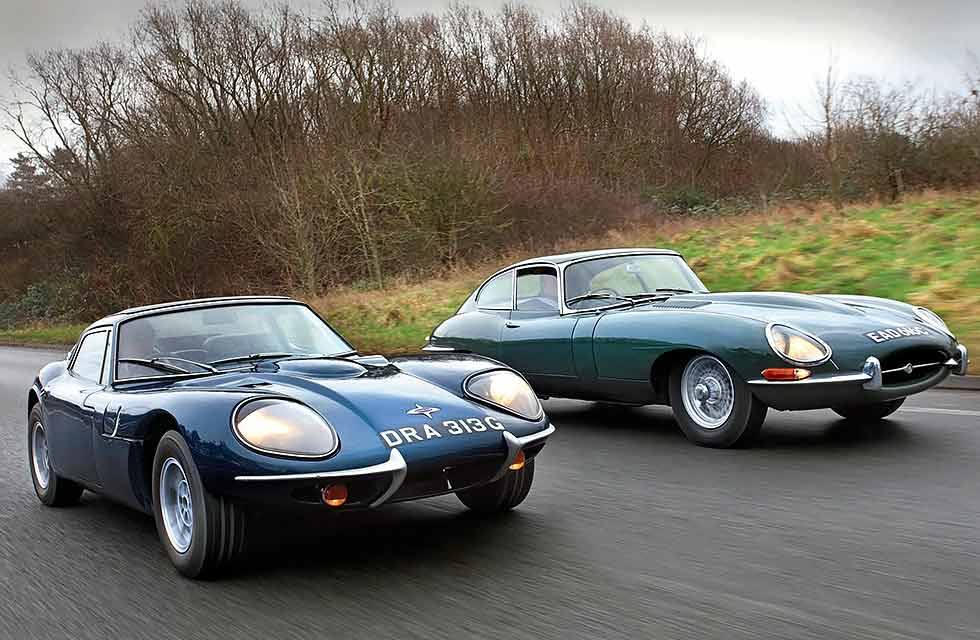
Strictly a closed two-seater of composite glassfibre and wooden construction, the original Marcos 1800 was an uncompromising sports car, the roadgoing progeny of the original gullwing and fastback (effectively race cars that happened to be road-legal). It put Marcos on the map. So low-slung it seemed almost a subversive activity, the Marcos GT was created in a shed in Wiltshire by noted racing driver and former builder of Austin Seven specials Jem Marsh.
‘The Marcos achieves much of what the suave Jaguar set out to do, but in a way that almost makes the E-type look bland’
By the time the 3-Litre was introduced in ’1968, Marsh looked like the next Colin Chapman. If Marsh’s idea of a GT car was not quite as refined and sophisticated as the fully independent, twin-cam-engined Jaguar, it was more intriguing. A lack of resources meant Marcos was open to experimenting with new materials and forced to come up with ingeniously cost-effective solutions from the parts bins of Ford, BMC, Triumph and others, while at the same time marshalling the innovative talents of the likes of Frank Costin and the Adams brothers.
More than mere plastic curiosity, the Marcos was a product of science, cunning and motorsport that asserted itself on the sports-car fraternity brightly but briefly. It caught the imagination of those who could afford an E-type but wanted to make a more individual statement – or wanted a car to build themselves. It was even less compromising in its driver appeal, too.
The Marcos looked like nothing else on the road, had the same appeal of the Jaguar and, while not exactly a hooligan’s car, had a more raucous and renegade image than a Lotus Elan.
To most Marcos owners, the E-type was probably too establishment. So embedded in the public psyche your granny could name it, so steeped in every cliché of the ‘Swinging Sixties’ that the more jaded among us are either immune to its considerable charms or (while noting its significance) just don’t think about it much.
I don’t think about Marcos 3-Litres often, either, unlike Richard Falconer. He would argue that the E-type and Marcos do compare well, being in possibly the unique position of having had both for most of his adult life. Following his first car, an Emeryson Climax Special, he’s owned the Marcos since 1973; he courted his wife in it, has repainted it at least twice and has rebuilt almost every part of it without actually restoring it. It’s almost a physical part of the man. He inherited the Series 1 4.2 E-type fhc 20 years ago from his late father, Peter, although he has been driving it for 50 years: “He let me take out the E by myself when I was 19 years old, with the strongly put advice that any accident would be my fault. That’s something I still abide by.”
Peter Falconer owned a succession of Jaguar saloons – from 3.4 Mk1 to XJ 2.8 – but kept the Sherwood Green 4.2 E-type, having crashed an earlier 3.8 Moss ’box car on a trip to Wales. “My father became friends with his client the Hon Edward Greenall and they both bought Es in 1962,” says Falconer. “Edward decided that the headlamp covers were too vulnerable and put aside a spare pair; 50 years later his son Gilbert gave them to me, still in their original boxes.”
While Falconer remembers the awe of both E-types, he also recalls when they were out of fashion in the ’70s: “A local dealer called on my dad and offered him £500; he wanted it for his wife ‘to smoke around in’.”
Later, Falconer would occasionally use it to take his youngest daughter to school: “As we arrived she would duck into the footwell.” Falconer’s future wife Virginia had been a family friend; her first ride in the E was in 1966. “I was crammed in the back,” he recalls, “she was in the passenger seat as unimpressed then as she is now. Her particular complaint had been that the car smelt of petrol. Only recently did we find pinholes in the tank and got a new one.”
His dad was a quick driver and Falconer’s late mother, who normally drove a Hillman Imp, was a nervous passenger who tended to press her feet to the floor searching for the phantom brake: “We think this is why there is an extra upholstered panel at the end of the footwell…”
The E has many original features, including the radio (still tuned to Radio 4 long-wave for his dad’s love of cricket), a compass and those beautifully preserved green leather seats, recently revived by local trimmer Richard James.
The car has been restored piecemeal as and when required, rather than being totally stripped down. So while being ‘original’ in feel, there is hardly a part that hasn’t had some attention. Local Jaguar specialist Tom Hinds has been looking after the E-type for most of its life. He recently rebuilt the engine and sent the gearbox to a man who built them in period at Jaguar.
Hinds has also worked on the Marcos, although whatever Falconer can’t manage on the 3-Litre is usually a job for former Marcos service manager Rory McMath: “I have known him since 1973. He works quickly and, apart from me, he is the only person I would trust to repair a wooden Marcos chassis.” The blue 3-Litre is one of only 100 wooden versions built before Marcos changed to a steel-tube structure (also designed by Dennis Adams), coinciding with the move to the new factory at Westbury. The light, strong marine ply and the general composite nature of the car is part of the appeal for Falconer: “I love that Marcos was producing an advanced composite chassis in a Wiltshire shed in 1964. But, to me, the whole point of the Marcos is not just that it is made out of wood but that it depends on the glassfibre body for rigidity. The steel chassis doesn’t derive much strength from the glassfibre body.
“The wooden chassis was incredibly accurate because of the table-top jig. In those days, steel chassis tended to distort with welding. The wood does rot, but then steel rusts.” Peter Adams designed the chassis of the Volvo-engined GT of 1964, brother Dennis the body. As well as being slippery, it still looked modern in 1971 when Marcos closed. “In many ways, Peter’s chassis was superior to Costin’s earlier efforts,” reckons Falconer. “It had straight load paths and was cleverly productionised.
The wooden chassis has a lot in common with the E; both are arrangements of torsion boxes attached to tubular front subframes.” Falconer’s 3 Litre is almost totally standard, down to its 13in alloys, and is thus a rarity. “Because both cars – especially the Marcos – teeter on the edge of bad taste,” he says, “they are best kept standard. Both are saved by simple block colours, sober wheels and stick-on black-and- white numberplates.”
With rear lights from the FB Vauxhall Victor, a car now probably rarer than the Marcos, it is a triumph of simplicity. “The single BL numberplate light doubles as a boot release and looks great,” adds Falconer.
It is a good-looking car, no question, with a stance more modern than the narrow-tracked Jaguar. The E looks huge alongside. The Marcos stands just 3ft 6in high – so low that, when getting his XJ6 out of the garage one day, Peter Falconer couldn’t see it and reversed into it. You wonder how you are going to get in – and getting out is even more undignified. However, the laid-back driving position and vertical wheel placement feel natural, as though you are wearing the car like a glove. The all-black, mostly plastic cockpit trumps the E-type with electric windows, a tiny sunshine roof and built-in headrests.
The seat doesn’t adjust but the pedal box moves with the turn of a wheel on the dash. “Jem was 6ft 4in, so he produced a car that tall people can drive,” says Falconer, who finds the E cramped. “I once took out the Jag’s driver’s seat and chucked in the one from the Marcos – bliss!’ You can manipulate the Marcos’ tiny pedals to best effect in stockinged feet, controlling the car with a delicacy that is more seamless thought-process than conscious action. There’s just complete and faithful response, with lots of roadholding. All of which is traded off against a very hard but somehow not punishing ride.
The semi-prone, low-slung driving position makes the acceleration feel more dramatic than it probably is, yet it matches the E-type for effortless thrust from what Falconer calls the ‘blue-collar’ Essex V6, sourced from Ford’s Industrial Power division. Compact and utilitarian compared to the Jaguar’s elegant twin-cam, it makes short work of the Marcos’ 1900lb, shrugging off the handicap of the Transit van/ Zodiac-type ratios in the gearbox. First is so low that starting in second doesn’t make that much difference to the acceleration rate, and you can play tunes on the overdrive in third and top.
You sit much taller in the Jaguar, with greater vision and far more storage space. It has fewer creaks and rattles, but is not notably quieter. The E-type is similarly unconcerned about which gear it is in, and there is a refinement to the drivetrain that gives the Jaguar limousine-like low-speed manners. You can reach almost 80mph in second or go straight from first to top; squeeze the throttle and let the superb torque wind itself out in a creamy rush.
It’s a strong but gentle sports car, with forgiving controls of even weight and responsiveness; the smooth, medium-to-light steering is alert and free from load-up. The ride is incredibly supple, which Peter Falconer appreciated but this has far less appeal for his son.
If he loves the Jaguar for its originality, its connection with his father and their history, Falconer’s heart lies with the Marcos – the car he chose for himself as a young man and that has thrilled and frustrated him for 46 years.
For Falconer, there is something about the ‘men-in-sheds’ spirit of the Marcos, a plucky individualism that gives it an appeal that is more than the sum of its parts. He admits it’s “not a rational position”, but what is rational about owning any old car? As a vehicle to lift the spirits, stimulate the senses and tell the story of clever people trying to do something interesting when everything seemed to be up for grabs, the Marcos can be compared with anything. Including an E-type. It need make no apologies for itself, because as a classic two-seater, six-cylinder close-coupled GT, it achieves much of what the suave Jaguar set out to do but in a way that almost makes the E-type look bland.
“Put it this way,” says Falconer. “Given the choice between lunch with William Lyons or Marsh, it would be Marsh every time – although I know who would end up paying!”
